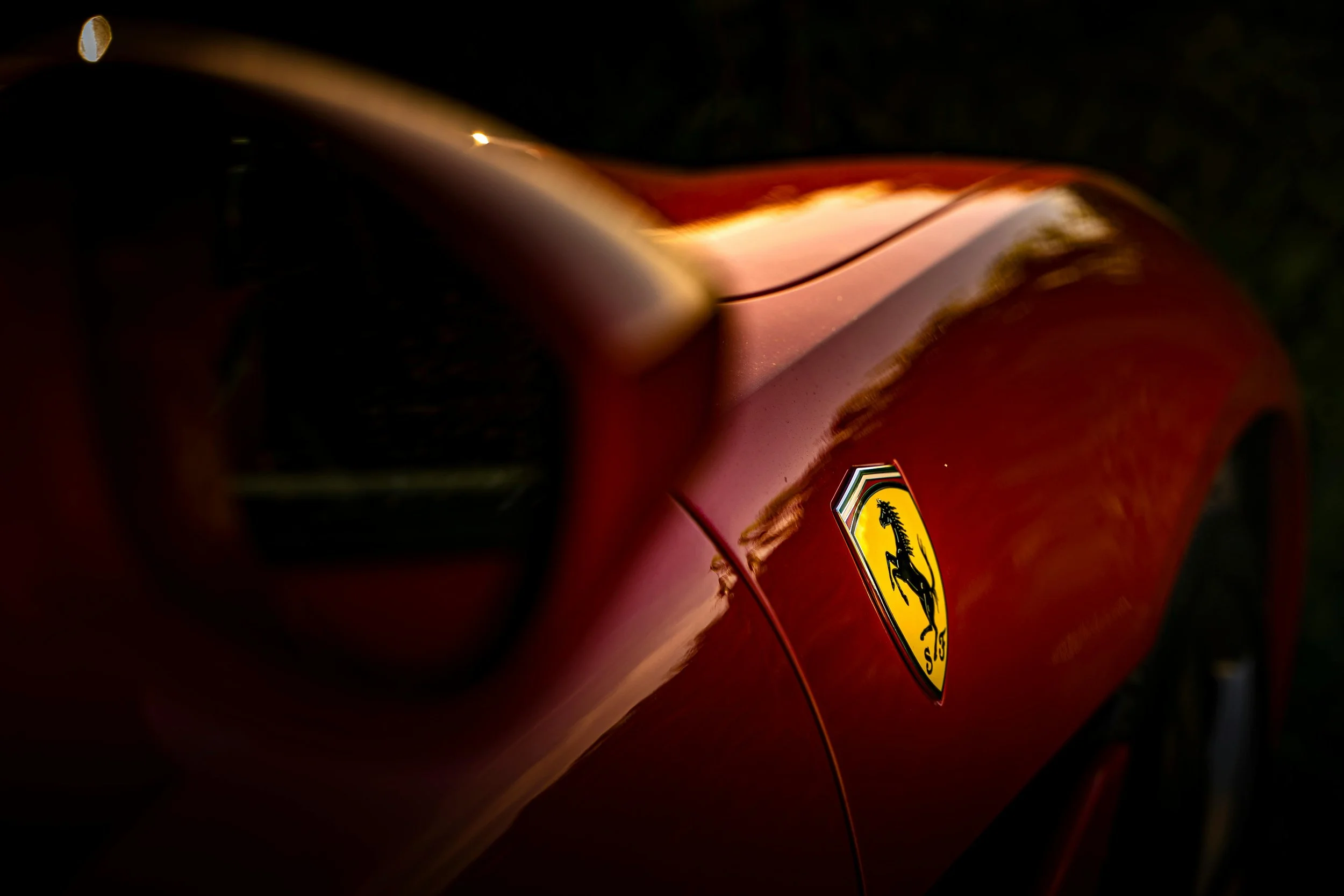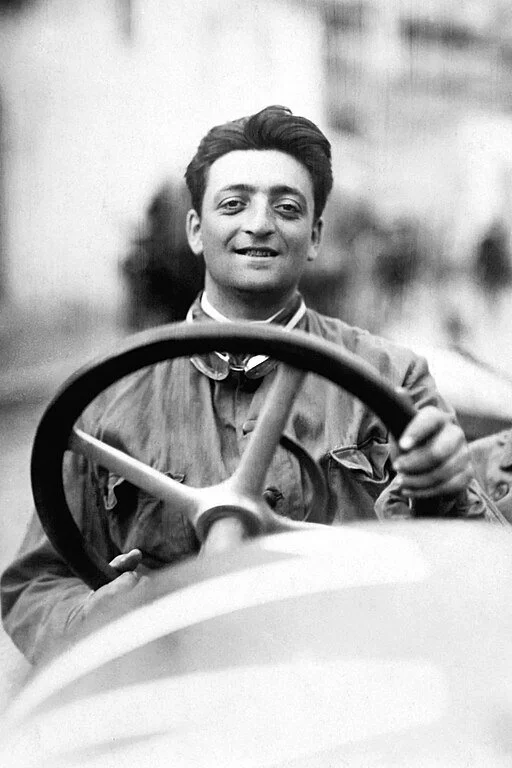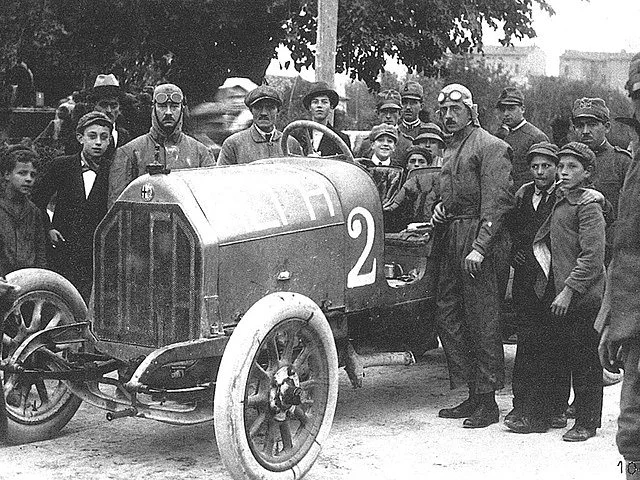Enzo Ferrari – Der Mann, der den Mythos erschuf Teil 1 von 4:
Einleitung – Der Anfang einer Legende
Ferrari – eine Marke, die heute für Geschwindigkeit, Leidenschaft, technische Perfektion und italienische Eleganz steht. Doch hinter dem weltberühmten Cavallino Rampante (dem springenden Pferd) steckt ein Mann, dessen Lebensweg ebenso dramatisch, widersprüchlich und faszinierend ist wie die Motoren, die seinen Namen in die Welt hinaustrugen: Enzo Anselmo Ferrari.
In diesem ersten Teil unserer dreiteiligen Serie tauchen wir tief ein in die frühen Jahre dieses außergewöhnlichen Mannes, der aus einfachsten Verhältnissen stammte und mit unerschütterlichem Ehrgeiz, strategischem Denken und einer fast religiösen Hingabe zur Geschwindigkeit die Scuderia Ferrari gründete – das wohl legendärste Rennteam der Automobilgeschichte.
Wir beleuchten:
Enzos Kindheit und Jugend in Modena
Seine prägenden Erfahrungen im Ersten Weltkrieg
Die Karriere als Rennfahrer bei Alfa Romeo
Die Gründung der Scuderia Ferrari 1929
Der Weg zur Unabhängigkeit und der Bau des ersten echten Ferrari 1947
Und selten erzählte Details, die selbst eingefleischte Ferrari-Fans überraschen dürften.
1. Die Wurzeln des Mythos: Kindheit und Jugend in Modena
1.1 Die Geburt eines Träumers – Enzo Ferraris frühe Jahre zwischen Dampf, Stahl und Sehnsucht
Modena, 18. Februar 1898 – eine Stadt, in der das Herz Italiens in Stein und Stahl schlägt. Noch liegt der industrielle Fortschritt in den Kinderschuhen, doch zwischen dampfenden Lokomotiven, dem metallenen Klang von Schmiedehämmern und dem Klang alter Kirchenglocken kommt ein Junge zur Welt, der die Welt des Motorsports revolutionieren sollte. Sein Name: Enzo Anselmo Giuseppe Maria Ferrari. Ein Name, der in den kommenden Jahrzehnten zu einer der glanzvollsten Legenden der Automobilgeschichte werden würde – doch davon war an diesem kalten Wintermorgen noch nichts zu ahnen.
Ein Zuhause in Bewegung: Die Familie Ferrari
Enzos Vater, Alfredo Ferrari, war kein Mann des großen Reichtums, aber einer mit Ambitionen und technischem Verständnis. Er führte eine kleine mechanische Werkstatt – Officina Meccanica Ferrari –, die Achsen und andere Metallteile für die italienische Eisenbahn herstellte. Diese Werkstatt war mehr als nur ein Arbeitsplatz – sie war ein Ort, an dem sich Enzos frühes Weltbild formte. Bereits als Kind beobachtete er mit glühender Neugier, wie Metall geschnitten, geformt und zu Leben erweckt wurde. Der Geruch von Schmieröl, die Hitze des Ofens, das rhythmische Klopfen auf den Amboss – das alles brannte sich tief in sein Gedächtnis ein.
Enzo war das zweite Kind der Familie, nach seinem älteren Bruder Alfredo, genannt „Dino“. Ihre Mutter, Adalgisa Bisbini, war eine Frau mit starker Willenskraft, die den jungen Enzo mit einer Mischung aus Strenge und Sensibilität erzog. Sie galt als große moralische Instanz im Haushalt – eine Eigenschaft, die Enzo in späteren Jahren oft zitieren würde, wenn er über seine eigene Disziplin sprach. Anders als oft vermutet, war Enzo kein charismatischer Junge, sondern eher still, introvertiert, fast melancholisch. Doch unter der Oberfläche arbeitete ein feuriger Geist.
Ein Rennen, das alles veränderte
Das Jahr 1908 markierte einen Wendepunkt im jungen Leben Enzo Ferraris. Sein Vater nahm ihn und seinen Bruder mit zum Circuito di Bologna, einem der ersten organisierten Autorennen in Italien. Für Enzo war es ein Erlebnis wie aus einer anderen Welt. Die lärmenden, pfeifenden Maschinen – waghalsige Konstruktionen auf vier Rädern, dampfend, rasselnd, über den groben Asphalt donnernd – übten auf ihn eine Faszination aus, die er nie mehr loswerden sollte.
„Ich wusste nicht, was ein Rennwagen war. Aber als ich das erste Mal das Donnern der Motoren hörte, wusste ich: Das ist meine Welt.“
– Enzo Ferrari (spätere Memoiren)
Während viele Jungen seiner Generation von Pferden, Soldaten oder Abenteurern träumten, fixierte sich Enzo fortan auf diese neuen Götter aus Metall und Feuer. Er sammelte Bilder von Fahrern wie Vincenzo Lancia und Felice Nazzaro, zeichnete Autos in seine Schulhefte und begann, erste technische Fragen zu stellen. Diese Begeisterung war mehr als kindlicher Spieltrieb – sie war eine Art Berufung.
Modena im Wandel – Ein Spiegel seiner Entwicklung
Es ist bemerkenswert, wie sehr Enzos persönliche Entwicklung mit dem Wandel Modenas verknüpft war. Während die Stadt langsam von der landwirtschaftlich geprägten Gesellschaft in ein industrielles Zentrum überging, entwickelte auch Enzo ein wachsendes Verständnis für Technik, Innovation und mechanische Präzision. Der Einfluss seines Vaters kann dabei nicht hoch genug bewertet werden. Alfredo Ferrari, ein Anhänger des technischen Fortschritts, förderte Enzos Interessen, auch wenn er wohl nie geahnt hätte, welche Weichen damit gestellt wurden.
Doch das Glück währte nicht ewig. In den Jahren 1915–1916 wurde Enzos Familie von einer Tragödie heimgesucht: Innerhalb kürzester Zeit verloren sie erst seinen Bruder, dann seinen Vater an die Grippeepidemie und gesundheitliche Komplikationen. Die Werkstatt wurde geschlossen, und Enzo, gerade volljährig, stand plötzlich vor einem Leben voller Unsicherheit. Er war mittellos, ohne Berufsausbildung, und dennoch fest entschlossen, etwas aus seinem Leben zu machen – im Zeichen des Motorsports.
1.2 Der Erste Weltkrieg: Zerstörung und Isolation
Als Enzo Ferrari im Jahr 1916 seinen Vater und seinen Bruder verlor, befand sich Italien mitten in einem der verheerendsten Konflikte der modernen Geschichte: dem Ersten Weltkrieg. Die Industrialisierung hatte das Kriegswesen verändert – Artillerie, Maschinengewehre, Giftgas. Die Landschaft Europas wurde zermalmt, ebenso wie Millionen junger Leben. Auch Enzo wurde nicht verschont: Kaum war er 18 geworden, wurde er zur italienischen Armee eingezogen – und erlebte an der Front eine Form der Realität, die nichts mit seiner metallglänzenden Faszination für Maschinen zu tun hatte.
Dienst in der Hölle – Die alpine Artillerie
Enzo wurde der Alpini-Artillerie zugeteilt, einer Spezialeinheit, die in den schwer zugänglichen Gebirgsregionen Norditaliens operierte. Seine Hauptaufgabe bestand darin, Maultiere zu beschlagen und zu pflegen, denn sie waren in unwegsamem Gelände oft zuverlässiger als Fahrzeuge. Die romantische Vorstellung des Maschinenzeitalters, die ihn als Kind verzaubert hatte, wurde jäh durch das tägliche Grauen des Stellungskriegs ersetzt.
Der Dienst im Hochgebirge war nicht nur physisch belastend – mit Temperaturen weit unter dem Gefrierpunkt und schwerem Gerät auf dem Rücken –, sondern auch psychisch zerstörerisch. Ferrari war mit Tod, Hunger, Kälte und Angst konfrontiert. Das Maultier wurde sein treuester Gefährte, seine Funktion als Hufschmied eine der wenigen Aufgaben, die ihn mit einem Gefühl von Ordnung inmitten des Chaos verbanden.
„Ich lernte im Krieg nicht, wie man kämpft, sondern wie man überlebt – in der Kälte, im Schweigen, mit dem Geruch von Schießpulver in der Nase.“
– Enzo Ferrari (aus einem Interview von 1963)
Die große Grippe und die Flucht aus dem Tod
Im Winter 1918 – wenige Monate vor Kriegsende – wurde Enzo von der berüchtigten Spanischen Grippe heimgesucht, einer Pandemie, die weltweit mehr Menschenleben forderte als die Schlachten selbst. In einem kleinen Feldlazarett, umgeben von Verwundeten, ohne Medikamente oder Wärme, rang er mit hohem Fieber tagelang um sein Leben.
Wie durch ein Wunder überlebte er. Doch körperlich war er geschwächt, seine Moral am Boden. Als er 1919 endlich entlassen wurde, war er ein anderer Mensch. Die Leichtigkeit und Lebensfreude seiner Kindheit war verschwunden. Zurück blieb ein Mann, der in kürzester Zeit alles verloren hatte – Vater, Bruder, Kindheit, Gesundheit – und nur noch eines besaß: einen unzerstörbaren Willen.
Modena nach dem Krieg – Ein Ort der Schatten
Enzo kehrte in eine Stadt zurück, die sich fremd anfühlte. Die Werkstatt seines Vaters war geschlossen, die Familie verarmt. Freunde aus Kindheitstagen waren gefallen, andere verkrüppelt. Es war eine Zeit der Ungewissheit. Italien war wirtschaftlich und gesellschaftlich zerrüttet – und niemand kümmerte sich um einen ehemaligen Hufschmied mit dem Traum, Rennfahrer zu werden.
Und doch war da etwas in ihm, das sich nicht unterkriegen ließ. Die Nähe zum Tod hatte ihm eine Klarheit geschenkt, die viele nie erreichen. Er hatte überlebt – und er würde sein Leben nutzen. Die Sehnsucht nach Geschwindigkeit, nach Technik, nach Wettbewerb – sie erwachte erneut. Und so begann Enzo, seine Fühler auszustrecken.
2. Die Entdeckung des Motorsports: Vom Testfahrer zum Champion
2.1 Der Einstieg über Umwege: CMN und der erste Wettkampf
Die Rückkehr Enzo Ferraris ins zivile Leben war von Unsicherheit geprägt. Das Italien nach dem Ersten Weltkrieg war ein zerrissenes Land, gezeichnet von politischen Umbrüchen, wirtschaftlicher Instabilität und sozialem Elend. Fabriken schlossen, Arbeitsplätze waren rar, und viele junge Männer suchten Halt in radikalen Ideologien oder im kriminellen Milieu. Enzo aber hatte andere Pläne. Trotz körperlicher Schwäche und psychischer Narben hielt er an seinem Kindheitstraum fest: Er wollte Rennfahrer werden.
Die erste Enttäuschung: Absage von Fiat
Sein erster Schritt war fast schon naiv, aber typisch für Ferraris unerschütterliches Selbstbild: Er reiste nach Turin, um sich beim größten und prestigeträchtigsten Automobilhersteller Italiens zu bewerben – Fiat. Doch Fiat, das gerade dabei war, sich in der Nachkriegsproduktion neu zu orientieren, hatte kein Interesse an einem unerfahrenen jungen Mann mit militärischem Hintergrund und ohne formale technische Ausbildung.
Die Absage war ein tiefer Schlag. Ferrari selbst bezeichnete diesen Moment später als eine seiner prägendsten Niederlagen – nicht weil sie ihn entmutigt hätte, sondern weil sie ihn zwang, den indirekten Weg zu wählen. Es war das erste Mal, dass er sich nicht auf Talent oder Glück verlassen konnte, sondern auf Beharrlichkeit und Improvisation.
Der Zufall rettet den Traum: Costruzioni Meccaniche Nazionali (CMN)
In derselben Stadt, nur wenige Straßen von Fiats glänzender Zentrale entfernt, existierte ein kleiner, fast unscheinbarer Automobilhersteller: CMN – Costruzioni Meccaniche Nazionali. Ursprünglich als Rüstungsbetrieb gegründet, versuchte CMN nach Kriegsende, auf den zivilen Automobilmarkt umzusteigen – mit sehr begrenztem Erfolg.
Ferrari, hungrig und entschlossen, klopfte an ihre Tür. Und anders als bei Fiat hatte er diesmal Glück: CMN suchte einen Testfahrer für ihre neuen Modelle. Man bot ihm kein Gehalt, aber die Chance, zu fahren – und für Enzo war das alles, was zählte.
„Ich war kein Angestellter. Ich war ein Bittsteller, der ihnen beweisen wollte, dass ich zu Großem bestimmt war.“
– Enzo Ferrari, in einem Interview aus den 1960ern
Parma-Poggio di Berceto 1919 – Das erste Rennen
Wenige Monate nach seinem Einstieg bei CMN bekam Enzo die Gelegenheit, an seinem ersten offiziellen Rennen teilzunehmen: dem Bergrennen von Parma nach Poggio di Berceto, einem 85 Kilometer langen, extrem anspruchsvollen Kurs in der Emilia-Romagna. Das Fahrzeug: ein umgebauter CMN 15/20 HP, eigentlich ein Straßenfahrzeug, dessen Karosserie notdürftig abgespeckt wurde, um Renncharakter zu erlangen.
Enzo war nicht der Favorit. Sein Auto war schwer, untermotorisiert, und das Team hatte kaum Erfahrung im Motorsport. Dennoch zeigte er Biss: Er fuhr aggressiv, mutig, teilweise riskant. Am Ende belegte er den vierten Platz in seiner Klasse – ein beachtlicher Erfolg, wenn man bedenkt, dass er gegen erfahrene Fahrer mit besserem Material antrat.
Die Bedeutung dieses Moments
Für Ferrari war dieses Rennen mehr als ein sportlicher Achtungserfolg – es war die Bestätigung, dass er im Spiel war. Er hatte es auf die Strecke geschafft. Er hatte gezeigt, dass er nicht nur von Geschwindigkeit träumte, sondern sie auch leben konnte. Noch war er weit davon entfernt, als ernsthafter Konkurrent zu gelten – aber in seinem Innersten hatte sich etwas verfestigt: Er gehörte auf den Asphalt.
Der Name Ferrari tauchte zum ersten Mal in den Rennberichten der Tagespresse auf – winzig gedruckt, fast beiläufig. Doch Enzo schnitt ihn aus, rahmte ihn ein und hängte ihn über sein Bett. Er war überzeugt, dass dies der Beginn von etwas Großem war.
2.2 Alfa Romeo und die ersten Siege
Wenn der Rennsport Enzo Ferrari die Augen geöffnet hatte, dann war Alfa Romeo das erste Fenster, durch das er hindurch in die Welt des großen Motorsports blicken durfte. Der Eintritt in die Reihen dieses aufstrebenden Automobilherstellers bedeutete für Ferrari nicht nur einen Karrieresprung – es war der Moment, in dem er begann, sich vom Fahrer zum Visionär zu entwickeln.
Ein Name mit Ambitionen: Alfa Romeo in den 1920ern
Alfa Romeo – ursprünglich als Anonima Lombarda Fabbrica Automobili (A.L.F.A.) gegründet – war nach dem Ersten Weltkrieg unter Leitung des Ingenieurs Nicola Romeo zu einer ernstzunehmenden Kraft im Automobilbau geworden. Bereits 1920 war Alfa ein aufstrebender Hersteller mit sportlichem Ruf, aber ohne konstante Rennsiege. Genau hier sah Enzo seine Chance.
Ferrari bewarb sich nicht nur als Fahrer, sondern trat mit einer Idee von Teamstruktur und Organisation auf, wie man sie im Rennsport damals kaum kannte. In einer Ära, in der viele Fahrer ihre Fahrzeuge selbst vorbereiteten und mit minimaler Unterstützung antraten, sah Enzo bereits das Potenzial einer engen Symbiose zwischen Fahrer, Ingenieur und Mechanikern.
Das erste Rennen mit Alfa – Targa Florio 1920
Sein erstes Rennen für Alfa Romeo war die Targa Florio 1920, eines der härtesten Straßenrennen der Welt – 432 Kilometer über die serpentinenreichen Straßen Siziliens. Enzo trat mit einem Alfa Romeo 40/60 HP an – einem wuchtigen Boliden mit 6,1-Liter-Motor und fast 90 PS. In einem chaotischen, staubigen und technisch überaus anspruchsvollen Rennen belegte Ferrari den zweiten Platz – eine Sensation.
„Ich hatte keine Vorstellung davon, wie ich diesen Wagen sicher über die Berge Siziliens bringen sollte. Aber ich wusste: Wenn ich es nicht versuche, werde ich nie erfahren, ob ich es kann.“
– Enzo Ferrari über die Targa Florio 1920
Dieses Ergebnis festigte seine Position im Team. Mehr noch: Es war der Beginn einer engen Verbindung zwischen Enzo und Alfa Romeo, die über ein Jahrzehnt andauern sollte.
Die goldenen Jahre als Fahrer – 1921 bis 1924
In den folgenden Jahren fuhr Enzo zahlreiche Rennen für Alfa Romeo – nicht immer mit spektakulären Ergebnissen, aber mit zunehmender Konstanz und einem feinen Gespür für Technik. Zwischen 1921 und 1924 nahm er an über 40 Rennen teil, darunter die Coppa Acerbo, Parma-Berceto, die Mugello-Rundstrecke und der Circuito del Savio.
Während viele Fahrer den Nervenkitzel in den Vordergrund stellten, begann Enzo das Rennen wie ein Schachspiel zu sehen. Er studierte Strecken, Wetterbedingungen, Konkurrenz, Mechanik. Er wurde bekannt für seine Fähigkeit, ein Rennen nicht unbedingt zu gewinnen, aber bestmöglich zu beenden – mit intaktem Wagen, sauberem Fahrstil und taktischem Gespür. Seine wenigen Siege – darunter das Circuito del Savio 1923 – waren keine Triumphfahrten, sondern strategische Meisterstücke.
Ein Name, ein Symbol – Das Cavallino Rampante entsteht
Eben dieses Rennen – der Circuito del Savio 1923 – markiert auch die Geburtsstunde eines Symbols, das später zur Ikone werden sollte: das Cavallino Rampante, das springende Pferd.
Nach dem Rennen wurde Ferrari von Enrico Baracca, dem Vater des im Ersten Weltkrieg gefallenen Jagdfliegers Francesco Baracca, angesprochen. Baracca, der Nationalheld, hatte ein springendes schwarzes Pferd auf seinem Flugzeug geführt. Die Familie schlug Enzo vor, dieses Symbol auf seinen Autos zu verwenden – als Zeichen von Mut und Glück.
„Stellen Sie das Cavallino Rampante auf Ihre Wagen – es wird Ihnen Glück bringen.“
– Contessa Paolina Baracca, 1923
Ferrari tat es. Er passte das Wappen leicht an, setzte es auf gelbem Grund – der Farbe seiner Heimatstadt Modena – und machte es Jahre später zum Herzstück seiner Marke.
Der stille Rückzug vom Cockpit
1924 erhielt Enzo ein verlockendes Angebot von Fiat, dem Konzern, der ihn Jahre zuvor abgelehnt hatte. Doch er lehnte ab. Noch immer war er Alfa Romeo tief verbunden. In den Folgejahren spürte er jedoch, dass er als Fahrer seine Grenzen erreicht hatte. Die jüngeren Konkurrenten waren risikofreudiger, oft auch waghalsiger. Enzo hingegen dachte langfristiger, mechanischer, unternehmerischer.
1927 zog er sich schrittweise vom aktiven Rennsport zurück. Sein letztes offizielles Rennen war 1931 – die Drei-Städte-Rundfahrt „Tre Province“, bei der er immerhin Dritter wurde. Zu diesem Zeitpunkt war sein erster Sohn, Alfredo „Dino“ Ferrari, gerade geboren – und Enzo hatte begonnen, in anderen Bahnen zu denken.
„Ich habe nie aufgehört, Rennen zu lieben. Ich habe nur aufgehört, selbst zu fahren. Weil ich wusste, dass ich größere Rennen noch vor mir hatte.“
– Enzo Ferrari
3. Die Gründung der Scuderia Ferrari: Eine neue Ära beginnt
3.1 Der Traum vom eigenen Team
Ende der 1920er-Jahre war Enzo Ferrari kein Star der Strecke mehr, doch er war in der italienischen Rennsportszene eine feste Größe. Er hatte Erfahrung, ein weitreichendes Netzwerk und – vielleicht das Wichtigste – einen klaren Plan. Seine Rennen hatten ihn gelehrt, dass Siege nicht nur durch Fahrkunst errungen werden, sondern durch Organisation, Technik, Strategie und ein starkes Team im Hintergrund. In einer Zeit, in der Motorsport oft noch als waghalsige Männerdomäne ohne Struktur galt, erkannte Enzo das Potenzial einer professionellen Rennorganisation – mit Mechanikern, Ingenieuren, Testfahrern, Logistik und vor allem: Vision.
Die Vision: Ein Rennstall für Gentlemen-Fahrer
Enzos Idee war revolutionär für ihre Zeit: Er wollte eine Art Privatteam gründen, das Amateuren – meist vermögenden Privatleuten, sogenannten „Gentleman Drivers“ – ermöglichte, mit hochklassigem Material an Rennen teilzunehmen. Diese Fahrer sollten nicht ihre eigenen Autos vorbereiten oder auf sich allein gestellt sein, sondern auf ein professionelles Team zurückgreifen können. Ferrari erkannte eine Marktlücke: Es gab viele leidenschaftliche Hobbyrennfahrer, aber kaum Strukturen, sie zu unterstützen.
Zugleich war es ein Schachzug mit Weitsicht: Wer die Amateurfahrer betreute, baute Beziehungen auf – zu Geldgebern, zu Alfa Romeo, zur Presse. Enzo Ferrari dachte wie ein Stratege – nicht in Rundenzeiten, sondern in Systemen.
„Der Fahrer ist ein Teil des Rennwagens. Aber das Team ist das Rückgrat des Sieges.“
– Enzo Ferrari
Die offizielle Gründung: 16. November 1929
Am 16. November 1929 war es so weit: In Modena, in der Via Trento e Trieste, gründete Enzo zusammen mit einer Handvoll lokaler Unternehmer die Scuderia Ferrari. Die Gründung wurde nicht als spektakuläres Ereignis gefeiert, sondern fand im kleinen Kreis statt – aber die Bedeutung war epochal. Die „Scuderia“ (italienisch für „Rennstall“) sollte bald zum berühmtesten Teamnamen der Automobilgeschichte werden.
Die frühen Unterstützer waren teils vermögende Modeneser Unternehmer – etwa Alfredo Caniato, ein wohlhabender Textilfabrikant, sowie Mario Tadini, ein aristokratischer Rennsportenthusiast. Auch ein nicht unwesentlicher Teil der Finanzierung stammte von Alfa Romeo selbst, das großes Interesse daran hatte, durch die Scuderia eine Art halboffiziellen Satelliten-Rennstall aufzubauen – mit Ferrari als Verbindungsmann zwischen Werk und Rennstrecke.
Der erste Rennstall ohne eigenes Auto
Ein interessanter Aspekt der frühen Scuderia Ferrari war: Sie baute anfangs keine eigenen Autos. Stattdessen betrieb das Team Alfa-Romeo-Fahrzeuge, die es vorbereitete, wartete und für Rennen optimierte. Das Team wurde so zum inoffiziellen Werksteam von Alfa – mit einem enormen Maß an Freiheit.
Zwischen 1930 und 1937 setzte die Scuderia über 40 Fahrer in verschiedensten Rennen ein – darunter auch Tazio Nuvolari, der als vielleicht größter italienischer Rennfahrer aller Zeiten gilt. Enzo hatte ein Auge für Talent, aber auch eine klare Linie: Nur wer diszipliniert, technisch interessiert und loyal war, durfte für ihn fahren. Fahrer waren für ihn Soldaten, die für eine Idee kämpften – für „seine“ Scuderia.
Das Cavallino Rampante wird zum Symbol
Jetzt – und nicht erst mit der Gründung des Ferrari-Autoherstellers – begann das springende Pferd seinen Siegeszug. Enzo, der es 1923 von der Familie Baracca erhalten hatte, ließ es von einem befreundeten Künstler stilisieren und kombinierte es mit dem gelben Wappen von Modena. Auf den Wagen der Scuderia Ferrari prangte es fortan stolz – ein Symbol für Kraft, Eleganz, Rebellion und italienische Exzellenz.
„Das Cavallino ist nicht mein Besitz. Es gehört der Idee Ferrari. Und die ist größer als ich.“
– Enzo Ferrari
Erste Erfolge und wachsender Einfluss
Die Scuderia Ferrari nahm bald an so gut wie allen großen Rennen teil: der Mille Miglia, der Targa Florio, dem Grand Prix von Italien. Die Ergebnisse waren beachtlich, doch es war vor allem der professionelle Auftritt, der für Aufsehen sorgte. Während andere Teams improvisierten, trat Ferrari mit Uniformen, vorbereiteten Wagen, Taktik und Reserveplänen auf – ein Novum.
Die Presse sprach bald von der Scuderia Ferrari als dem „preußischen Regiment auf italienischem Boden“ – diszipliniert, effizient, siegeshungrig.
3.2 Das Cavallino Rampante – Mythos mit Flügeln
Ein Symbol aus dem Krieg
Es war das Jahr 1923, als Enzo Ferrari, damals noch ein junger Rennfahrer bei Alfa Romeo, den Großen Preis von Savio in Ravenna gewann – ein regional bedeutendes Rennen, aber für Ferrari der Auftakt zu einer lebensverändernden Begegnung. Nach dem Rennen wurde er eingeladen, den Grafen und die Gräfin Enrico und Paolina Baracca kennenzulernen – die Eltern von Francesco Baracca, Italiens berühmtestem Jagdflieger im Ersten Weltkrieg.
Francesco Baracca war zu Lebzeiten ein Nationalheld: über 30 bestätigte Luftsiege, ein Ehrenzeichen der Tapferkeit, Pilot der legendären italienischen Fliegerstaffel „Squadriglia degli Assi“. Auf der Seite seines Flugzeugs – einer SPAD S.XIII – prangte das Emblem eines aufbäumenden schwarzen Pferdes: das „Cavallino Rampante“. Es war ursprünglich das Wappen eines alten Reiterregiments der italienischen Armee – Baracca hatte es übernommen, um seine Herkunft zu ehren.
Nach Baraccas Tod 1918 im Dienst wurde das Emblem zum Inbegriff von Mut, Patriotismus und Opferbereitschaft. Bei der Begegnung mit Enzo Ferrari überreichte Gräfin Baracca ihm feierlich das Wappen ihres gefallenen Sohnes – mit den Worten, die in Enzos Gedächtnis brannten:
„Setzen Sie das springende Pferd auf Ihre Wagen. Es wird Ihnen Glück bringen.“
– Paolina Baracca
Ferrari war tief bewegt. Für ihn war das nicht einfach eine freundliche Geste – es war eine Übergabe von Geist und Verantwortung. Baracca hatte in der Luft gekämpft, Enzo würde es auf der Straße tun. Beide verband der Drang nach Geschwindigkeit, Präzision und Disziplin.
Ein neues Wappen entsteht
Obwohl Enzo das Cavallino schon 1923 annahm, vergingen mehrere Jahre, bis er es wirklich öffentlich nutzte – denn zu diesem Zeitpunkt fuhr er noch unter dem Alfa-Banner. Erst mit der Gründung der Scuderia Ferrari 1929 und ihrer Etablierung als ernstzunehmende Kraft im Motorsport wurde das Emblem wieder hervorgeholt, überarbeitet und in ein eigenständiges Wappen eingebettet.
Er gab dem schwarzen Pferd einen gelben Hintergrund – nicht zufällig, sondern als Hommage an seine Heimatstadt Modena, deren Stadtfarben gelb und blau sind. Darüber setzte er die Buchstaben „S F“ für Scuderia Ferrari. Die ursprünglichen Flügel des Baracca-Wappens ließ er jedoch weg – nicht, um sich vom Ursprung zu entfernen, sondern um die Richtung zu ändern: Das Pferd blickte fortan nach rechts, zum Fortschritt, zur Zukunft, zur Ideallinie.
Die erste öffentliche Verwendung des Cavallino durch Ferrari datiert auf das Jahr 1932, beim Rennen Spa 24 Stunden – und wie die Legende es wollte, gewann Ferrari mit dem Logo auf den Fahrzeugen.
Symbolik, Psychologie und Wirkung
Ein springendes Pferd ist kein zufälliges Motiv. In der Ikonographie steht es für:
Unbändigkeit – ein Tier in Bewegung, nicht zu zähmen.
Stärke und Anmut – Kraft, die nicht plump ist, sondern kontrolliert.
Freiheit – es ist kein gezähmtes Reittier, sondern ein Ausdruck des wilden Geistes.
In Ferraris Fall wurde das Cavallino zu einem psychologischen Emblem: Es sollte Fahrern Mut machen, Gegner einschüchtern, und Kunden das Gefühl geben, Teil von etwas Größerem zu sein. Die schlichte schwarze Silhouette auf gelbem Grund wirkt auf den ersten Blick elegant – doch sie brennt sich ein, wird zum Brandzeichen auf Motorhauben, Trikots, Pokalen.
Abgrenzung zu anderen Pferden – Ein Duell der Marken
Oft wird die Ähnlichkeit zum Logo von Porsche diskutiert, das ebenfalls ein springendes Pferd zeigt. Tatsächlich führt Porsche sein Wappen auf das Stadtwappen von Stuttgart zurück – einer Stadt, die auf einem Gestüt gegründet wurde („Stutengarten“).
Doch hier zeigt sich ein feiner, aber bedeutender Unterschied: Das Porsche-Pferd wirkt gesättelter, symmetrischer, fast statisch – während das Ferrari-Cavallino aggressiv, dynamisch und fast explodierend wirkt. Bei Porsche ist es Teil eines Wappens. Bei Ferrari ist es das Wappen.
Enzo selbst hatte dazu einmal gesagt:
„Andere Marken haben Pferde. Unseres läuft frei.“
– Enzo Ferrari
Die Ewigkeit des Symbols
Heute ist das Cavallino Rampante eines der bekanntesten Embleme der Welt – gleichauf mit Apple, Coca-Cola oder Nike. Es steht nicht nur für eine Automarke, sondern für einen Lebensstil. Für einen Mythos, der sich nicht in PS oder Preis ausdrückt, sondern in Geschichten, Emotionen, Triumphen und Tragödien.
Es ist ein Symbol, das nicht altert – weil es nie wirklich der Gegenwart gehört hat. Es stammt aus dem Ersten Weltkrieg, wurde im goldenen Zeitalter des Motorsports geschmiedet und lebt heute auf Hypercars weiter, die mehr Computer als Maschine sind. Und doch: Jedes Mal, wenn ein Ferrari mit dem Cavallino beschleunigt, galoppiert auch der Geist Baraccas – und Enzos – ein Stück weiter.
(in der Fortsetzung Teil 2 folgt:)
Kapitel 4: Der Bruch mit Alfa Romeo und der erste "echte" Ferrari
Kapitel 5: Maranello wird zur Geburtsstätte des Mythos
Kapitel 6: Enzo Ferrari als Unternehmer, Perfektionist und Kontrollfreak
👉Was dir in Zusammenhang mit Ferrari auch gefallen könnte:
Enzo Ferrari – Der Mann, der den Mythos erschuf Teil 2 von 4
Enzo Ferrari – Der Mann, der den Mythos erschuf Teil 3 von 4:
Enzo Ferrari – Der Mann, der den Mythos erschuf Teil 4 von 4:





